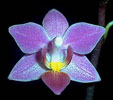|
|
|
|
|
| |
Flasks of
Phalaenopsis equestris 'Rebecca' AM/AOS × self |
|
| |
|
|
| |
| Number: |
TN2920 |
| Name: |
Phalaenopsis equestris 'Rebecca' AM/AOS × self
|
| Type: |
self (What's that?) |
|
Seed Donor: |
CJ Maciejeski
|
|
Click to Enlarge

Pod Parent Flower |
|
|
|
| |
Culture Notes from Donor: Parent plant: Temperature range W (70-90°F)
Comments: Parent plant: Small plant. A particularly well-formed cultivar, this plant is highly awarded by the American Orchid Society. All segments glowing magenta-pink, dorsal sepal sparkling, lighter towards base and edges; petals somewhat wider than dorsal sepal, lightly ruffled, same color as other segments; lateral sepals spotted on lower half of basal area; labellum slightly darker than other segments, sidelobes deep reddish-magenta, callus shield-shaped, intense golden yellow, lightly speckled cinnamon. Substance firm for species, texture crystalline, form exceptional. Natural spread of flower 2.8 cm horizontally, 3.5 cm vertically; dorsal sepal 1.0 cm wide, 1.7 cm long; lateral petals 1.1 cm wide, 1.4 cm long; lateral petals 0.9 cm wide, 1.6 cm long; labellum 0.9 cm wide, 1.5 cm long.
For additional origin/habitat information supplied courtesy of
Charles and Margaret Baker, see further below, near the bottom of this page.
|
Temperatures we attempt to use in the lab & greenhouse:
| For Species: |
|
Spring, Summer, Autumn, Winter: days average 88°F, nights 72°F; best fit is Warm 90-70°F
(Source:
Baker's Web OSC) |
| For Genus: |
|
Spring, Summer, Autumn, Winter: days average 87°F, nights 64°F; best fit is Warm-Intermediate 87-64°F
(
) |
|
About the name...
| Etymology of |
equestris |
|
From Latin "equestris" riding, one leaf upon the other.
(Source:
Mayr & Schmucker 1998) |
| Etymology of |
equestris |
|
From Latin "equestris" riding. In the case of genus Phalaenopsis, this refers to the saddle-shaped labellum.
(Source:
Troy Meyers) |
| Etymology of |
Phalaenopsis |
|
From Greek, "phalaina" moth; "-opsis" appearance.
(Source:
Pridgeon 1992) |
| Pronunciation of |
equestris |
|
ee-KWES-tris
(Source:
Hawkes 1978) |
| Pronunciation of |
Phalaenopsis |
|
fail-eh-NOP-sis
(Source:
Pridgeon 1992) |
| Pronunciation of |
Phalaenopsis |
|
fal-eye-NOP-sis
(Source:
Hawkes 1978) |
|
If you would like to direct someone to this web page, please copy and paste this URL into your email:
http://troymeyers.com/d?012920
| Flask Information |
| Availability: |
Capsule failed. We were not able to make any flasks. |
| You should: |
Consider placing a "Notify Retries" Request, and if an identical pollination (the same parents) is done again, we'll let you know. |
|
You might also want to:
|
View items of the same species.
View items of the same genus.
|
| Ordering Information |
| You are not currently logged in. |
|
You must be a registered user and be logged in to reserve a flask or place a notification request. Please log in:
|
|
|
|
|
|
| |
The origin/habitat information below is supplied courtesy of Charles and Margaret Baker
The following information is based on the name of the plant provided by the donor, and assumes that the name is correct. If the plant has been misidentified, then the following information may not be correct.
This text is copyrighted by the Bakers and may not be reproduced without permission.
ORIGIN/HABITAT: Luzon Island, Philippines, to Taiwan at 0-990 ft. (0-300
m), near streams in hot valleys.
More about this information and the Bakers...
|
|
|
| |
|
|
|